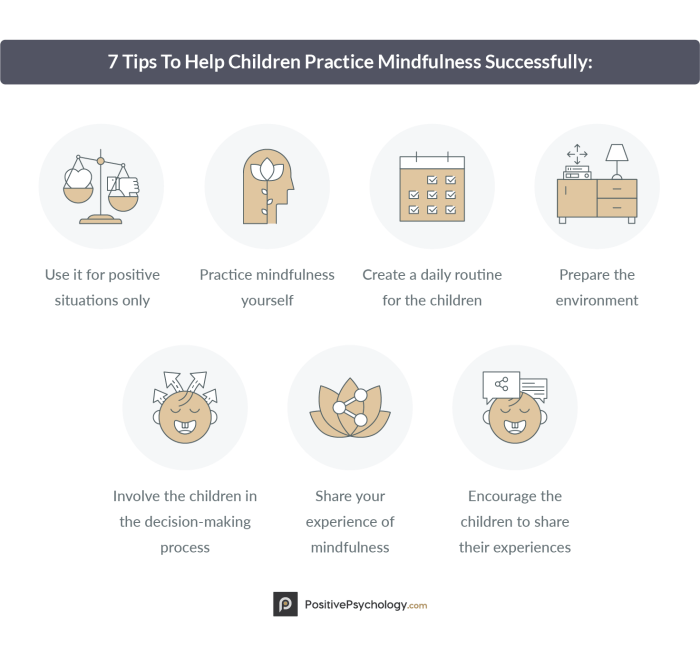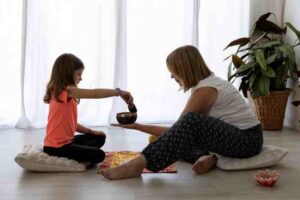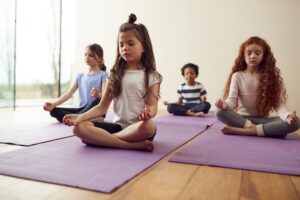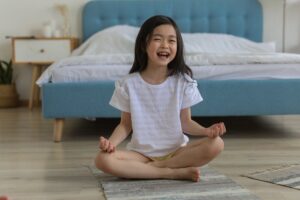7 Simple Little Children’s Meditation Techniques for Calming the Mind bring a wave of tranquility to young minds, offering a path to peaceful thoughts and centered spirits. Dive into the world of meditation for kids with these easy and effective techniques that promise to soothe even the wildest of imaginations.
From breathing exercises to creative expression through art, this guide is a treasure trove of calming methods tailored for the little ones. Get ready to embark on a journey of mindfulness and relaxation with your child, one peaceful breath at a time.
Introduction to Children’s Meditation Techniques: 7 Simple Little Children’s Meditation Techniques For Calming The Mind

Children’s meditation refers to the practice of teaching young individuals how to focus their mind, relax their body, and cultivate a sense of inner peace and calmness. It involves simple techniques that are tailored to suit the needs and understanding of children, helping them develop emotional resilience and self-awareness.Teaching meditation to children is crucial in today’s fast-paced and often stressful world.
By introducing them to mindfulness practices at a young age, we equip them with valuable tools to navigate challenges, manage emotions, and build a strong foundation for mental well-being.
Benefits of Meditation for Kids’ Mental Health
- Mental Clarity: Meditation helps children clear their minds and improve focus, concentration, and cognitive function.
- Emotional Regulation: By learning to observe their thoughts and feelings without judgment, kids can better manage stress, anxiety, and negative emotions.
- Enhanced Self-Awareness: Meditation cultivates a sense of self-awareness in children, helping them understand their emotions, thoughts, and behaviors.
- Improved Sleep: Regular meditation practice can promote better sleep patterns and quality of rest for children.
- Reduced Stress: Mindfulness techniques can reduce stress levels in kids, promoting a sense of calm and relaxation.
Breathing Exercises
Breathing exercises are simple techniques that can help children calm their minds and relax their bodies. These exercises focus on the breath, which is a powerful tool for promoting relaxation and reducing stress.Deep breathing can help calm the mind by activating the body’s relaxation response. When we take slow, deep breaths, it signals to the brain that everything is okay and helps to reduce feelings of anxiety and tension.
Confidence building is vital for children’s personal development. By practicing 15 Little Children’s Meditation Techniques for Confidence Building , kids can enhance their self-assurance and belief in themselves.
Deep breathing also increases oxygen flow to the brain, which can improve focus and concentration.
Peaceful minds are essential for children’s mental health. Through 15 Simple Little Children’s Meditation Exercises for Peaceful Minds , kids can cultivate inner calmness and reduce stress.
Basic Breathing Exercise for Children
- Find a comfortable seated position and close your eyes.
- Place one hand on your belly and the other hand on your chest.
- Take a slow, deep breath in through your nose, feeling your belly rise as you fill your lungs with air.
- Hold your breath for a moment, then slowly exhale through your mouth, feeling your belly fall as you release the air.
- Repeat this process for several breaths, focusing on the sensation of your breath moving in and out of your body.
Visualization Techniques

Visualization techniques can be a powerful tool in helping children calm their minds by engaging their imagination and creativity. By guiding children to create vivid mental images, these techniques can help shift their focus away from worries or stressors, promoting a sense of peace and relaxation.
Children’s meditation is a valuable practice for building self-esteem. By incorporating 10 Little Children’s Meditation Techniques for Building Self-Esteem , kids can learn to connect with themselves and boost their confidence.
Age-Appropriate Visualization Exercises, 7 Simple Little Children’s Meditation Techniques for Calming the Mind
- Imagine floating on a fluffy cloud, feeling weightless and free.
- Picture a beautiful garden filled with colorful flowers and gentle butterflies.
- Visualize a magical bubble surrounding you, protecting you from negativity.
The Role of Imagination in Visualization Techniques
Visualization techniques rely heavily on the power of imagination to create calming and soothing mental images. Children’s vivid imaginations allow them to transport themselves to peaceful and serene places, helping them to relax and unwind. Encouraging children to tap into their creativity through visualization exercises can be an effective way to help them manage stress and anxiety.
Emotional management is crucial for children’s well-being. Utilizing 15 Little Children’s Meditation Tips for Managing Emotions can aid kids in understanding and regulating their feelings effectively.
Mindfulness Activities

Practicing mindfulness helps children develop self-awareness, focus, and emotional regulation. It involves paying attention to the present moment without judgment. Here are some interactive mindfulness activities for kids that can help reduce stress and promote well-being.
Managing emotional health is a priority for children’s overall wellness. Implementing 25 Little Children’s Meditation Practices for Managing Emotional Health can equip kids with tools to cope with various emotions effectively.
1. Mindful Breathing Exercise
- Have children sit or lie down comfortably.
- Encourage them to focus on their breath, feeling it go in and out.
- Guide them to notice how their chest or belly rises and falls with each breath.
- Remind them to bring their attention back to their breath if their mind wanders.
2. Mindful Listening Activity
- Ask children to close their eyes and listen carefully to the sounds around them.
- Have them identify different sounds without labeling or judging them.
- Encourage them to focus on the details of each sound, such as its volume and pitch.
- Guide them to stay present and attentive to the sounds for a few minutes.
3. Body Scan Meditation
- Guide children to focus on different parts of their body, starting from their toes and moving up to their head.
- Encourage them to notice any sensations, tensions, or feelings in each body part.
- Teach them to breathe into any areas of discomfort and release tension with each exhale.
- Help them relax and let go of any physical or emotional stress they may be holding onto.
Movement-Based Meditation

Movement-based meditation is a wonderful way to engage children in mindfulness practices while also incorporating physical activity. By combining movement and meditation, kids can experience a holistic approach to calming the mind, enhancing focus, and promoting relaxation.
Benefits of Incorporating Movement into Meditation for Children
- Encourages physical activity: Movement-based meditation allows children to engage in gentle exercises while also practicing mindfulness.
- Promotes mind-body connection: By linking movement with breath and awareness, kids can develop a deeper connection between their bodies and minds.
- Enhances focus and concentration: Moving through yoga poses or simple exercises can help children improve their ability to concentrate and stay present in the moment.
- Reduces stress and anxiety: The combination of movement and meditation can help children release tension, calm their minds, and reduce feelings of stress or anxiety.
Simple Yoga Poses Suitable for Kids
- Child’s Pose: A calming and grounding pose that helps children relax and release tension.
- Tree Pose: Encourages balance and focus while also strengthening the legs and core.
- Cat-Cow Stretch: Promotes flexibility in the spine and helps children connect breath with movement.
- Butterfly Pose: Opens the hips and promotes relaxation in a gentle and accessible way.
How Movement-Based Meditation Can Enhance Focus and Relaxation
- By incorporating movement into meditation, children can release excess energy and tension, allowing them to focus more easily.
- Engaging in yoga poses or simple exercises can help children develop body awareness and learn to regulate their emotions.
- The combination of movement and mindfulness can create a sense of calm and relaxation, promoting a peaceful state of mind.
- Regular practice of movement-based meditation can help children build resilience to stress and improve their overall well-being.
Creative Expression through Art

Art can be a powerful form of meditation for children, allowing them to express themselves creatively while also calming their minds. Through art, children can explore their emotions, thoughts, and imagination in a non-verbal way, making it a great tool for mindfulness and self-reflection.
Examples of Art Activities for Mindfulness
- Creating a mandala: Drawing or coloring mandalas can help children focus their attention and promote a sense of calm and balance.
- Painting emotions: Encouraging children to paint how they feel can help them process and express their emotions in a healthy way.
- Nature art: Using natural materials like leaves, flowers, or rocks to create art can connect children with the present moment and the beauty of nature.
Therapeutic Effects of Artistic Expression
Artistic expression has numerous therapeutic effects on children’s mental well-being. It can help reduce stress and anxiety, improve self-esteem, enhance problem-solving skills, and foster emotional resilience. Through art, children can learn to regulate their emotions, develop a sense of identity, and cultivate a positive outlook on life.
Guided Imagery and Storytelling
Guided imagery is a technique that involves using the power of imagination to create a mental image or scenario that helps children relax, focus, and calm their minds. By guiding children through a story or visualization, they can engage their senses and emotions, promoting a sense of peace and well-being.
Storytelling Techniques for Relaxation
- Use descriptive language: Paint a vivid picture with words to help children imagine themselves in a peaceful and serene setting.
- Incorporate sensory details: Include sounds, smells, and textures to make the story more engaging and realistic.
- Encourage deep breathing: Integrate pauses in the story to prompt children to take deep breaths and relax their bodies.
- Create a safe space: Establish a nurturing and safe environment within the story where children can feel secure and at ease.
Tips for Creating Engaging Stories
- Keep it simple: Use language that is easy to understand and follow, tailored to the child’s age and comprehension level.
- Include positive affirmations: Integrate reassuring and uplifting messages to boost children’s self-esteem and confidence.
- Allow for creativity: Encourage children to visualize and add their own elements to the story, making it a personalized experience.
- End on a positive note: Conclude the story with a peaceful resolution or a message of hope and tranquility to leave children feeling calm and content.
As we wrap up our exploration of 7 Simple Little Children’s Meditation Techniques for Calming the Mind, remember that introducing these practices to your child can sow the seeds of serenity and emotional well-being early on. Embrace the power of meditation in nurturing a calm and focused young mind, setting the stage for a lifetime of inner peace.




